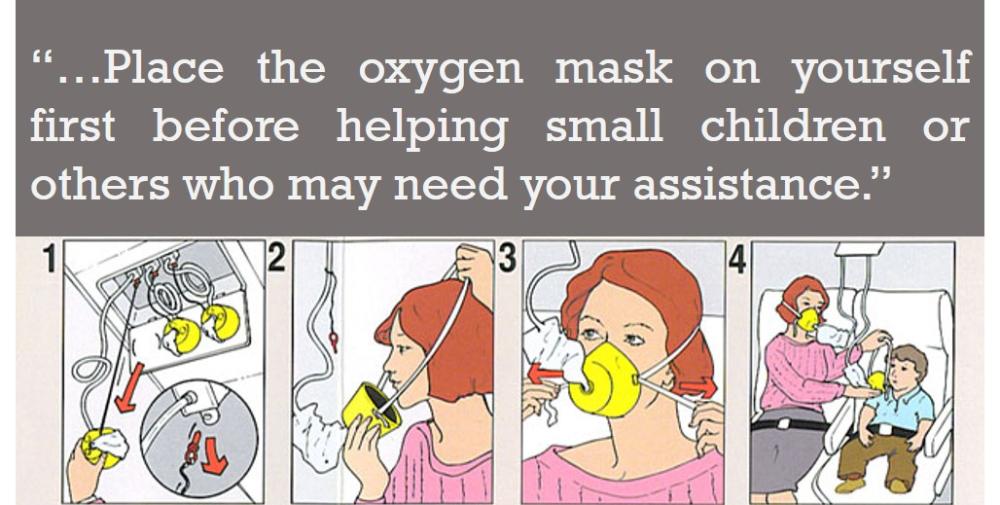
I am not sure about anyone else, but I could easily get overwhelmed by the things happening in our world today. And if you factor in the everyday events of being a single mom and business owner, with Winter and the holidays right around the corner, and it is the perfect recipe for a complete melt down.
There is so much going on in our world now, and taking care of ourselves can sometimes fall off our schedules entirely. While we can all justify not taking time for self-care, because we are so busy taking care of everyone else, we fail to see the importance of the Self in that equation.
Something that I often share with my clients is “The Oxygen Mask” theory. If you have ever flown on a commercial airplane, you have heard the flight attendants give the safety speech. They demonstrate how to fasten your seat belt, how to exit the plane safely, and how your seat cushion doubles as a flotation device. They tell you that in the event of an emergency, an oxygen mask may drop down from above your head. They make a point of telling you to put your own oxygen mask on first, before attempting to help anyone else.
The logic behind this is simple: If you pass out before you put your oxygen mask on - you aren’t there to help anyone else. Even less obvious, is that now someone else has to help you.
The “Oxygen Mask Theory” applies to everyday life on the ground as well. When we do not take the time to take care of ourselves, we fall victim to the effects of fatigue, illness, stress, and mood swings. All of these things prevent us from being the caregiver, and some of them can even remove us from the Caregiver role entirely.
I know that some of you are thinking that you have heard all this before, and you still have no idea how to fit this self-care stuff into your life. I want to share something that I teach my clients. It is so effective, so simple and quick that you will find yourself using it every day. I use it myself several times a day, and it works like a charm.
How to Breathe
We all breathe, all day, every day. We don’t even think about it most of the time. But there is a way to breathe that can improve your mood, sharpen your thinking, relieve pain, and calm your nerves instantly.
The way you breathe does make a difference. Try this. Place your hand over your abdomen and push your abdominal muscles out. You probably noticed that you inhaled as you pushed those muscles out - right? Good. Now, do it again. Push those abdominal muscles out, but this time continue the inhale, filling your lungs all the way up. Hold the breath for just a second, then exhale slowly. Great!
Do that a couple more times, and notice the differences that you feel. Calmer? Maybe smiling? Heart rate slowed down? Clearer? Pretty great, right?
Why it Works
There is Science going on here, besides just taking a moment to pause and focus on nothing but your breathing. That action all by itself is good for you, and keeps you from reacting to your environment in unhealthy ways. But there is more to it than that even…
When you push those abdominal muscles out, your diaphragm drops down, causing your lungs to open up at the bases. The diaphragm is the muscle that separates your chest and your abdomen.
By allowing your lungs to open up at the bases, you are getting fresh air down to the tiny air sacs called alveoli, that transfer oxygen to your bloodstream. There are many more of these alveoli at the bases of your lungs than up higher, so more oxygen is getting into your blood.
More oxygen in your blood means more oxygen going to your brain. And more oxygen in your brain makes you sharper and think clearer. The rest of your body is getting this oxygen rush too, and the result is an energized feeling, or a feeling of increased wellness.
Something else happens when you push your abdominal muscles out and lower your diaphragm. This physical activity stimulates your Vagus nerve. The Vagus nerve is the longest of the cranial nerves, sending out fibers from your brainstem to your visceral organs. The vagus nerve is the controller of your parasympathetic nervous system, overseeing a vast range of crucial functions, communicating nerve impulses to every organ in your body.
Stimulating the Vagus nerve by taking these deep abdominal breaths can reduce stress, anxiety, anger, and inflammation by activating the "relaxation response" of your parasympathetic nervous system. The Vagus nerves initiates the release of some key chemicals in your brain:
Serotonin - elevates your mood
Melatonin - calms the mind (and promotes sleep)
Dopamine - relieves pain
Lowers Cortisol levels
This combination of feel-good chemicals, oxygen-rich blood, and the brief pause to focus on your breathing is a simple and profoundly powerful way to ease stress anytime, anywhere.⧫
Karen Gray is a registered nurse, a certified hypnotist, and the director of Green Mountain Hypnosis in Lebanon, New Hampshire. For more information on self care strategies and reducing stress, contact Karen at info@greenmountainhypnosis.com, or call (802) 566-0464.